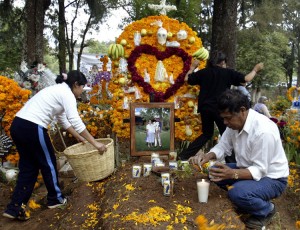Día de los Muertos
November 1, 2019
Today, November 1, as people digest the sweets collected on Halloween, many people begin another celebration: the Day of the Dead, or día de los muertos. As the name implies, the traditionally Mexican holiday honors the dead. The holiday is also celebrated in other Latin American countries and in Mexican American communities. During día de los muertos (or simply día de muertos), families gather in churches, at cemeteries, and in homes to pray for and remember deceased loved ones.

A family in Patzcuaro, Mexico, decorates the graves of deceased family members on Día de los muertos. Credit: © Henry Romero, Reuters
Día de los muertos is usually celebrated on November 1 and 2. Those days are the Roman Catholic feasts of All Saints’ Day and All Souls’ Day. The celebration combines ancient native beliefs and Catholic traditions. Many families prepare an elaborate altar, known as an ofrenda (offering), for the holiday. They set up the ofrendas in their homes and in cemeteries. The ofrendas are decorated with flowers, fruits, popular foods, sweets, and drinks. They are created to welcome back for a day the souls of departed family members and friends. Special creations such as calaveras (sugar skulls) and sweet pan de muerto (bread of the dead) are popular treats. Day of the dead food, decorations, and costumes traditionally incorporate skulls, skeletons, and other symbols of death.
The day of the dead reinforces the ancient belief that death is a part of life. It is an important tradition through which families pass on their oral histories. Recalling stories of past family members helps keep these ancestors alive for future generations.


